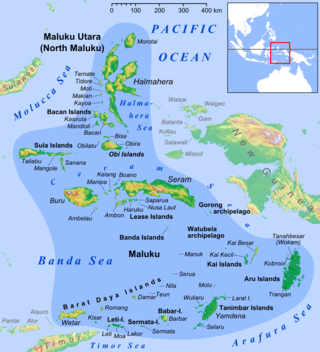
The Maluku Islands or the Moluccas are an archipelago in the eastern part of Indonesia. Tectonically they are located on the Halmahera Plate within the Molucca Sea Collision Zone. Geographically they are located east of Sulawesi, west of New Guinea, and north and east of Timor. Lying within Wallacea, the Moluccas have been considered as a geographical and cultural intersection of Asia and Oceania.

The Bacan Islands, formerly also known as the Bachans, Bachians, and Batchians, are a group of islands in the Moluccas in Indonesia. They are mountainous and forested, lying south of Ternate and southwest of Halmahera. The islands are administered by the South Halmahera Regency of North Maluku Province. They formerly constituted the Sultanate of Bacan.

North Maluku is a province of Indonesia. It covers the northern part of the Maluku Islands, bordering the Pacific Ocean to the north, the Halmahera Sea to the east, the Molucca Sea to the west, and the Seram Sea to the south. It shares a maritime borders with North Sulawesi,, Southeast Sulawesi and Central Sulawesi to the west, Maluku to the south, Southwest Papua to the west, and Palau and the Philippines to the north. The provincial capital is Sofifi on the largest island of Halmahera, while the largest city is the island city of Ternate. The population of North Maluku was 1,038,087 in the 2010 census, making it one of the least-populous provinces in Indonesia, but by the 2020 Census the population had risen to 1,282,937, and the official estimate as at mid 2022 was 1,319,338.

Ternate, also known as the City of Ternate, is a city in the Indonesian province of North Maluku and an island in the Maluku Islands. It was the de facto provincial capital of North Maluku before Sofifi on the nearby coast of Halmahera became the capital in 2010. It is off the west coast of Halmahera, and is composed of eight islands: Ternate, the biggest and main island of the city, and Moti, Hiri, Tifure, Mayau, Makka, Mano, and Gurida. In total, the city has a land area of 162.17 square kilometres and had a total population of 185,705 according to the 2010 census, and 205,001 according to the 2020 census, with a density of 1,264 people per square kilometre; the official estimate as at mid 2022 was 206,745. It is the biggest and most densely populated city in the province, is the economic, cultural, and education center of North Maluku, and acts as a hub to neighbouring regions. It was the capital of the Sultanate of Ternate in the 15th and 16th centuries, and fought against the Sultanate of Tidore over control of the spice trade in the Moluccas before becoming a main interest to competing European powers.

Tidore is a city, island, and archipelago in the Maluku Islands of eastern Indonesia, west of the larger island of Halmahera. Part of North Maluku Province, the city includes the island of Tidore together with a large part of Halmahera Island to its east. In the pre-colonial era, the Sultanate of Tidore was a major regional political and economic power, and a fierce rival of nearby Ternate, just to the north.
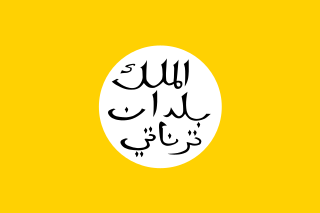
The Sultanate of Ternate, previously also known as the Kingdom of Gapi is one of the oldest Muslim kingdoms in Indonesia besides Tidore, Jailolo, and Bacan. The Ternate kingdom was established by Momole Cico, the first leader of Ternate, with the title Baab Mashur Malamo, traditionally in 1257. It reached its Golden Age during the reign of Sultan Baabullah (1570–1583) and encompassed most of the eastern part of Indonesia and a part of southern Philippines. Ternate was a major producer of cloves and a regional power from the 15th to 17th centuries.

The Sultanate of Tidore was a sultanate in Southeast Asia, centered on Tidore in the Maluku Islands. It was also known as Duko, its ruler carrying the title Kië ma-kolano. Tidore was a rival of the Sultanate of Ternate for control of the spice trade, and had an important historical role as binding the archipelagic civilizations of Indonesia to the Papuan world. According to extant historical records, in particular the genealogies of the kings of Ternate and Tidore, the inaugural Tidorese king was Sahjati or Muhammad Naqil whose enthronement is dated 1081 in local tradition. However, the accuracy of the tradition that Tidore emerged as a polity as early as the 11th century is considered debatable. Islam was only made the official state religion in the late 15th century through the ninth King of Tidore, Sultan Jamaluddin. He was influenced by the preachings of Syekh Mansur, originally from Arabia. In the 16th and 17th centuries, the sultans tended to ally with either Spain or Portugal in order to maintain their political role, but were finally drawn into the Dutch sphere of power in 1663. In spite of a period of anti-colonial rebellion in 1780–1810, the Dutch grip on the sultanate increased until decolonization in the 1940s. Meanwhile, Tidore's suzerainty over Raja Ampat and western Papua was acknowledged by the colonial state. In modern time, the sultanate has been revived as a cultural institution.

The Sultanate of Bacan was a state in Maluku Islands, present-day Indonesia that arose with the expansion of the spice trade in late medieval times. It mainly consisted of the Bacan Islands but had periodical influence in Ceram and the Papuan Islands. It fell under the colonial influence of Portugal in the 16th century and the Dutch East India Company (VOC) after 1609. Bacan was one of the four kingdoms of Maluku together with Ternate, Tidore and Jailolo, but tended to be overshadowed by Ternate. After the independence of Indonesia in 1949, the governing functions of the sultan were gradually replaced by a modern administrative structure. However, the sultanate has been revived as a cultural entity in present times.

Fort Oranje is a 17th century Dutch fort on the island of Ternate in Indonesia.

Fort Kastela is a ruined Portuguese fortress located at the southwest coast of Ternate. It is famous for being the first colonial fortification constructed in the Spice Islands (Maluku) of Indonesia. Built by the Portuguese in 1522, it is also referred to in different languages as São João Baptista de Ternate or Fortaleza de Ternate (Portuguese), Ciudad del Rosario (Spanish) or Gammalamma. Today it is locally known as Kastella/Kastela.
Sultan Hairun Jamilu was the 6th Muslim ruler of Ternate in Maluku, reigning from 1535 to 1570. During his long reign, he had a shifting relation to the Portuguese who had a stronghold in Ternate and tried to dominate the spice trade in the region. This ended with his assassination at the hands of a Portuguese soldier in 1570.
Sultan Mudafar Syah I, also spelt Muzaffar Syah, was the ninth Sultan of Ternate who ruled from 1606 to 1627. He reigned during an important transitional phase, when the Dutch East India Company gained ascendency in the Maluku Islands and began to regulate the commerce in spices. This was the beginning of the colonial subordination of Maluku that would accelerate during his successors.
Gava was a Sultan of Tidore in Maluku Islands who ruled briefly in the years up to 1560. His fairly obscure reign was characterized by an attempt to expand Tidore's territory in Halmahera which ended with his violent demise at the hands of his rival, the Sultan of Ternate.
Mole Majimun was the seventh Sultan of Tidore in Maluku Islands, who reigned from 1599 to 1627. He was also known as Sultan Jumaldin or Kaicili Mole. In his time the transition to the hegemony of the Dutch East India Company (VOC) began in eastern Indonesia, though Tidore held on to its traditional alliance with the Spanish Empire.
Sultan Gorontalo was the ninth Sultan of Tidore in Maluku Islands, ruling from 1634 to 1639. His brief reign was caught up in the tension between the Spanish Empire and the Dutch East India Company, leading to his violent death in 1639.
Sultan Saidi was the tenth Sultan of Tidore in Maluku islands. He was also known as Magiau and ruled from 1640 to 1657. His reign saw intermittent hostilities with Tidore's traditional rival, the Sultanate of Ternate, which included interference in an anti-Dutch rebellion in Ternate and Ambon and attempts to increase Tidorese territory in Maluku. By the time of Saidi's reign Tidore had gained a political position in parts of the Papuan territories.
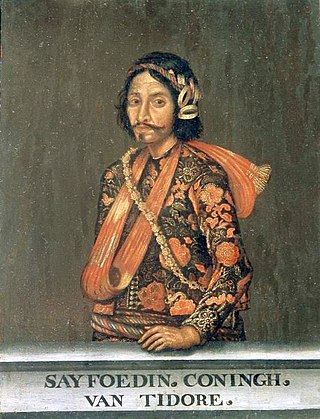
Sultan Saifuddin, also known as Golofino was the eleventh Sultan of Tidore in Maluku islands. Reigning from 1657 to 1687, he left Tidore's old alliance with the Spanish Empire and made treaties with the Dutch East India Company (VOC), which now became hegemonic in Maluku for the next century. Tidore was forced to extirpate the clove trees in its territory and thus ceased to be a spice Sultanate. In spite of this, Saifuddin and his successors were able to preserve a degree of independence due to the trade in products from the Papuan Islands and New Guinea.
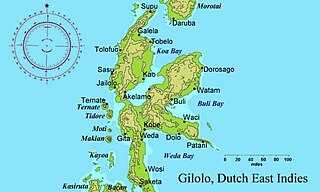
The Sultanate of Jailolo was a premodern state in Maluku, modern Indonesia that emerged with the increasing trade in cloves in the Middle Ages. Also spelt Gilolo, it was one of the four kingdoms of Maluku together with Ternate, Tidore, and Bacan, having its center at a bay on the west side of Halmahera. Jailolo existed as an independent kingdom until 1551 and had separate rulers for periods after that date. A revivalist Raja Jailolo movement made for much social and political unrest in Maluku in the 19th century. In modern times the sultanate has been revived as a symbolic entity.
Fort Kota Janji is a Portuguese fortress located at Jalan Ngade, Laguna Hamlet, Fitu Village, South Ternate District, Ternate, North Maluku Province. It is located on the side of the main road to Ternate City from the south. The fort, which stands firmly at a height of 50 metres (160 ft) above sea level, was originally built during the Portuguese colonial period. Construction was possibly initiated by Governor António de Brito in about 1522. It is locally believed that it was named Fort Kota Janji because it became a silent witness to the peace treaty between Sultan Hairun and the Portuguese Governor. However, the Portuguese broke their vows and took the sultan's life in nearby Fort Kastela in 1570. In 2004, restaurarion work was done at the site of the fort, but only through beautifying the area around the fort by creating a park and build a fence surrounding the site. However, the original shape of the fort is no longer visible.
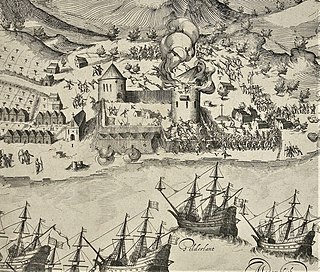
The Ternatean–Portuguese conflicts were a series of conflicts in the Spice Islands in eastern Indonesia between the Portuguese and their allies on one hand, and the Sultanate of Ternate and its allies, on the other. Hostilities broke out from time to time after the establishment of Portugal in Moluccas in 1522. The strongly Catholic and Muslim identities of the combatants gave the struggle elements of a war of religion, although this aspect was frequently blurred by cross-faith alliances. It was also an economic war since the Portuguese aim was to control export of the profitable trade in cloves. Portuguese-Ternatan rivalry later merged with attempts of expansion by the Spanish in the Philippines. The Portuguese were eventually defeated in 1605 by an alliance between the Dutch East India Company (VOC) and Ternate, ending their active involvement in Moluccas affairs. However, they were soon replaced by the Spanish who maintained an Iberian presence in the region up to 1663.
















